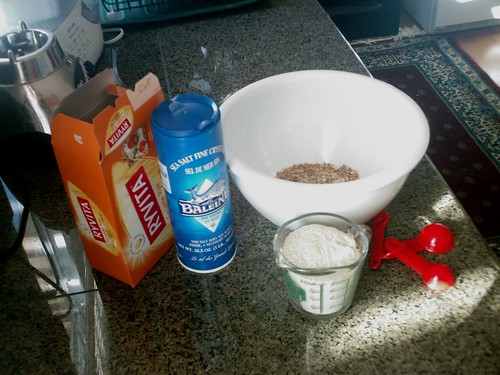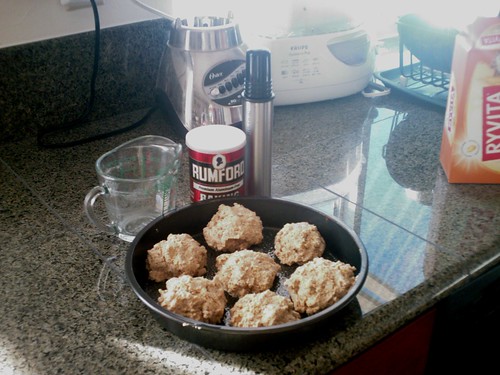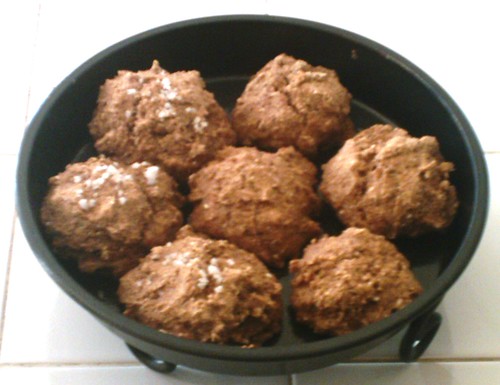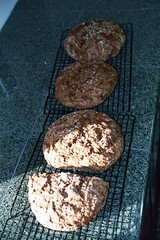This is my first entry into the world of the Daring Bakers’ monthly challenge. This month’s challenge recipe was something called a Strawberry Mirror Cake (but which I did in Raspberry instead). It involves heaps of dairy, and is about as far from anything Vegan as I’ve done in a loooong time. However, the people who consumed it said it was wonderful, so here’s to feel-good food.
The biggest surprise for me in this recipe was the complexity. In reading through it, you end up having to follow footnotes, essentially, to see how to make the components. Once you’re there, though, it’s not really as complicated as it seems, so I’d encourage you to simply step through, and you’ll get there. That said, the assembly involved quite a lot of work, and I found myself thinking that it must have been an “industrial” recipe or something; if you were to scale it up, and make a dozen of them, then you’d have just a bit more work (in terms of laying out cakes, slathering on Bavarian Cream, pouring gelatin), but you’d have a dozen cakes instead of just the one.
This was very much an effort for me, as I’m not particularly inclined to follow instructions on a good day – I tend to treat recipes as a list of ingredients that somebody thought was a good combination, the quantities as rough guides, and the instructions as a not-so-interesting narrative which has caused the ingredient list to be written in too-small of a font to be useful in the kitchen. That said, I tried and tried to follow the instructions, as per The Rules. I balked, however, at the idea of cutting away nearly 1/3 of the cake and simply throwing it away. I read the recipe over, concluded that I wouldn’t be throwing away all that cake, and deviated by using 3 8-inch pie plates to bake the cake in. I apparently should have then thrown away that extra cake, but I just included it in my cake.
What I ended up with (because I also was unwilling to go buy a bigger springform) was an enormous cake which threatened to escape the pan. I had to basically use my trowel spatula to carve out an area in which to pour the gelatin mirror, and then had to cover up the edges of my little pond of gelatin with cherries (I figured that, since the recipe used cherry liquor, it could benefit from some cherries on top, too).
If I were to make this cake again, I’d probably pipe in the Bavarian Cream, because I ended up with some irregularities around the edges, which detracted from the overall presentation. I’d also invert the bottom of the springform pan, so that it’d be easier to remove the cake (avoiding that annoying little lip). Other than that (and, well, using a larger springform pan), I think that the recipe is fairly straightforward, if labor intensive.
The mirror had bubbles: I slurped them off of the top with a straw … and I poured the mirror with the cake already settled onto a shelf in the fridge. I’m certain that any production kitchen would be horrified at the picture of a long-haired guy squatting in front of an open fridge … slurping away with a straw. But there it is, and was. It was the only possible way I could get the mirror onto the cake!
Just as interesting as the recipe, though, is the nutrition data for the strawberry version of this cake, and for the raspberry version (substitute 20oz frozen raspberries for the strawberries). Notice that I’ve got 24 cherries around this cake? Yep – each cherry is a single serving. So, if you’re like my dad, and you took 3 cherries on your first plate … well, let’s just say that you’ve eaten over half of your daily allowance of saturated fat in that one piece.
Strawberry Mirror Cake
Special Pans: 11 x 17″ Jelly Roll Pan, 10″ Springform Pan, 8 1/4″ Cake Round or Tin (or pattern)
Ingredients/Steps:
A. Strawberry Mirror Cake
- 3 eggs
- 3 egg yolks
- 0.75 cup sugar
- 1 tsp vanilla extract
- 3 egg whites
- 1/8 tsp cream of tartar
- 2 TBSP sugar
- 2/3 cup sifted cake flour
- 0.5 cup water
- 1/3 cups sugar
- 2 TBSP kirsch or strawberry liqueur
- Preheat oven to 450F. Butter and flour the sides of an 11-by-17 inch jelly roll pan(rimmed baking sheet). Line bottom of pan with a sheet of parchment paper cut to fit bottom pan exactly.
- Beat eggs, egg yolks and.75 cup sugar together in a medium bowl until thick and light. Beat in the vanilla.
- In a separate bowl, beat the egg whites until foamy, ad cream of tartar and beat until whites begin to form peaks. Add the 2 TBSP sugar and beat until the whites hold stiff, glossy peaks(do not over beat).
- Sift flour over the egg yolk mixture and fold in . Stir in one fourth of the whites. Then carefully fold in the remaining whites.
- Spread batter evenly in pan. Bake until light brown and springy to touch (7 to 10 minutes).
- Cool in pan 5 minutes. Run a knife along edge to loosen. Invert cake tin to cut out 8.25 inch circles of cake. Wrap the cake layers, separated with waxed paper, and set aside. Cake may be frozen at this point.
B. Strawberry Bavarian Cream
- 2.5 TBSP unflavored gelatin
- 1.5 cups strained strawberry puree(1.5 baskets)
- 5 egg yolks
- 2/3 cup sugar
- 1.5 cups milk
- 1 TBSP lemon juice
- several drops of red food coloring
- 1.75 cups whipping cream
- Sprinkle the gelatin over the strawberry puree in a small bowl and set aside until spongy.
- Combine egg yolks and sugar in a bowl’ beat until light. Bring milk to a boil in sauce pan. Pour hot milk into yolk mixture ans stir with a wooden spoon(it doesn’t say so but I would temper the egg mixture first to be safe). Return this mixture to the saucepan and cook over medium heat, stirring constantly, until your finger leaves a clear trail in sauce when drawn across the back of the spoon.(Do not boil or mixture will curdle.) Immediately remove from heat and stir in softened gelatin mixture. Pour into a stainless steel bowl places over a bowl of ice water. Stir in lemon juice and a few drops of red food coloring. Cool over ice water, stirring occasionally, until mixture thickens to the consistency of softly whipped cream.
- While gelatin mixture is cooling, whip the whipping cream until it holds soft peaks. When the gelatin mixture resembles softly whipped cream, fold the whipped cream into the gelatin mixture.
Strawberry Mirror
- 1 tsp lemon juice
- 1 TBSP kirsch
- 1 TBSP water
- 1 TBSP unflavored gelatin
- Few drops of red food coloring
- Prepare strawberry juice.
- Place lemon juice, kirsch, and water in a small bowl. Sprinkle gelatin over this mixture; set aside until spongy and soft.
- Measure 1.5 cups Strawberry juice into a small saucepan and bring to a simmer; pour over gelatin mixture and stir to dissolve gelatin. Tint to desired color with red food coloring. Place bowl over bowl of ice water and stir occasionally until the mixture is syrupy and just beings to thicken(do not let jell); remove from ice water.
- When mixture is syrupy, pour a 1/16-inch layer over the top of cake. Refrigerate until set.
Strawberry Juice
- 1.5 pints of strawberries(18 oz)
- .75 cup sugar
- .75 cup water
- Wash and hull strawberries; coarsely chop.
- Place strawberries in saucepan; crush to start juices flowing. Place over low heat; add sugar and water; simmer slowly 10 minutes.
- Pour juice and pulp through damp jelly bag or cheesecloth-lined colander and drain into a bowl for 15 minutes (Do not press down on fruit).








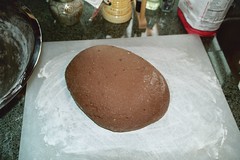
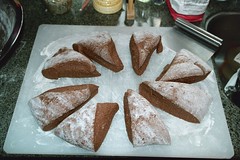
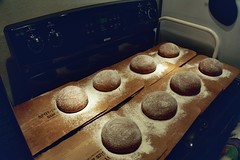
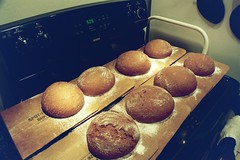
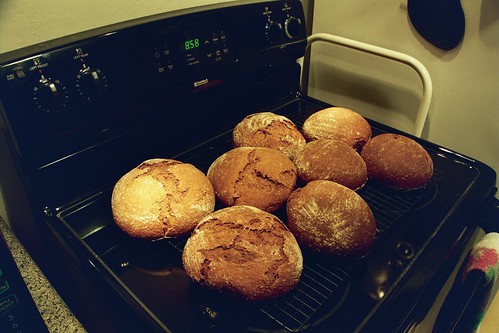
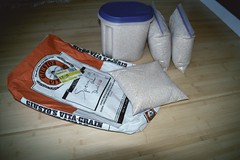

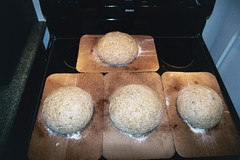
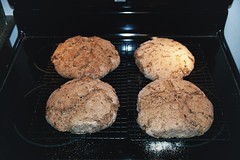

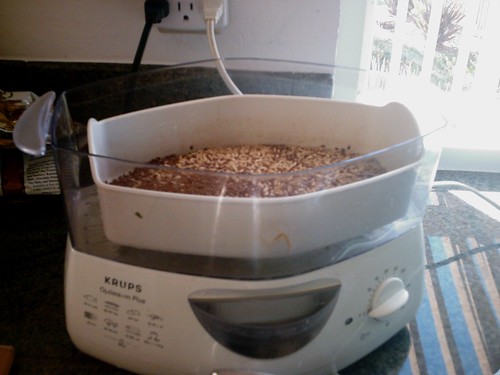 I thought I should blog about Baking Powder Biscuits this last week when I woke up and realized we hadn’t steamed
I thought I should blog about Baking Powder Biscuits this last week when I woke up and realized we hadn’t steamed 